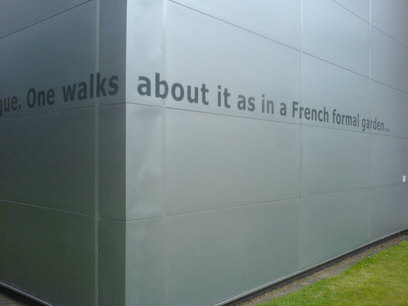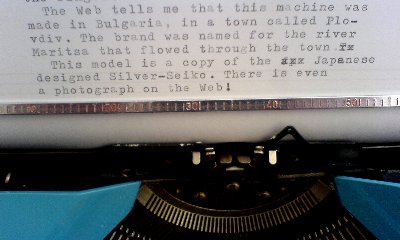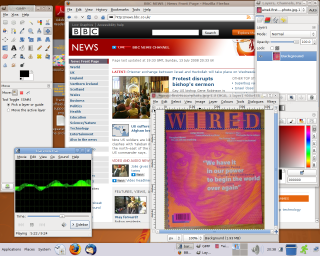August 1st, 2008

Today’s partial eclipse of the Sun viewed in projection through one half of a pair of binoculars. I had to work quickly – no time to set up a screen at a better angle – because of the rapidly moving cloud and rain showers floating around the Midlands at present. I think I missed the maximum of the partial eclipse at this latitude.
It is 40% of the Moon covering the Sun in Scotland, but only around 15% here in the Midlands. The eclipse is total in Northern Canada, Greenland, parts of Russia and China.
Nice to think of the approximate alignment of the Moon, Sun and my shed for a few hours…
Posted in Photos | Tags: astronomy, diy science, eclipse, home science | Comments Off
July 30th, 2008

Guess which USB device was not working properly?
Answer is in the ALT/TITLE tag of the image, so hold your mouse over the yellow balloon to see!
Posted in Notes | Tags: hci, usability, Windows | Comments Off
July 25th, 2008

Day science employs reasoning that meshes like gears… One admires its majestic arrangement like a da Vinci painting or a Bach fugue. One walks about it as in a French formal garden…
Night science, on the other hand, wanders blindly. It hesitates, stumbles, falls back, sweats, wakes with a start. Doubting everything… It is a workshop of the possible… where thought proceeds along sensuous paths, tortuous streets, most often blind alleys.
Francois Jacob, The Statue Within.
The photograph shows part of Nikki Pugh’s installation on the side of the Interdisciplinary Research Centre building on the Birmingham University campus. The Day science phase is in a sans font on the metal panels of the building, the Night science part of the quote is rendered in script on frosted glass or (‘powdered ceramic’) in front of light boxes in the windows of the building. I’ll try to get a picture with the back lights on – seems more atmospheric.
Posted in Notes, Photos | Comments Off
July 22nd, 2008

As you might have guessed, I’m still clearing out the boxes left over from the move. I wonder if I packed up my iBook today, and took it out in 2018, if it would work straight away? And if it did, would I be able to connect it to anything?
It was the mathematical symbols that got me into wordprocessing, that and graphics. If I wrote arguments and stories, i.e. text, then I can imagine that things could be different.
Posted in Notes | Comments Off
July 16th, 2008
“I once saw Tufte give a workshop in Chicago where he introduced a valuable concept. He said information may be displayed adjacent in space or stacked in time. Take a book for example. If two dots are on the same spread, they are adjacent in space. All it takes to switch between them is movement of your eye. Compare that to a dot on one page stacked above a dot on another page. You can’t see them at once. You have to flip back and forth between pages to see one dot versus the other.” Ryan,
Learning from “bad” UI, 37 Signals
Some people find Moodle cluttered and complex looking especially with editing switched on. I see everything I need to change a course next to the things I’m changing. No need to change page (or change my time to use Tufte’s metaphor). The article on 37 signals about a mileage claim application discusses the issues well.
Posted in ILT, Learning | Comments Off
July 13th, 2008

Hardy Heron 8.04.1 appears to work fine on my Asus Pundit P1 box (AMD dual core, integrated graphics, very quiet). Installed easily and the NVIDIA drivers were downloaded and recognised my no name monitor. Bling works including the wobbly windows (but I tend to use ‘medium’ bling settings in the appearance tab). The ‘buy from magnatune’ button does not work in Rhythmbox, but I have been listening to CBC for the last 10 minutes.
8.04 beta 2 was a little rough around the edges although it ran fine on the Pundit. A clean install of this patch appears to have smoothed off a lot of the burrs. Having separate home and root partitions helps to preserve my data and preferences while installing different flavours of linux.
Posted in Ubuntu | Tags: linux, open source, operating systems | Comments Off
July 12th, 2008
“It destroys memory and weakens the mind, relieving it of work that makes it strong. It is an inhuman thing.â€
Who said this, and what was the ‘it’?
I’ve had various answers over the last few weeks while I’v been doing staff development with teachers. I’ve had ‘the Internet’ and ‘Google’, and even ‘no it’s wider than that, perhaps the whole of it’. After a few hints, I’ve had ‘printing’. Close – the quote is from Plato’s Phaedra and is attributed to Socrates. The technology in question was writing. My point is that people were worried about the effect of technology on our minds and ways of thinking 2500 years ago, and possibly before that.
I’m trying to find reasons why busy teachers in FE Colleges might want to start using elearning with students. I’m finding that many already use blogs and MSN with students. Most are using e-mail to cut feedback time down. These are all valid uses of e-learning according to the inspectors definition…
“E-learning is learning facilitated and supported through the use of ICT. It may involve the use of computers, interactive whiteboards, digital cameras, the internet, the college intranet, virtual learning environments and electronic communication tools such as email, discussion boards, chat facilities and video conferencing. E-learning should form part of the overall teaching and learning strategy for courses. There should be appropriate references to e-learning in schemes of work, lesson plans, assignments, course reviews and staff development plans. An overall strategy for e-learning should be supported by senior managers†Ofsted Handbook for Inspecting Colleges, April 2007, Ref 070075
I have the quote above up on PowerPoint (it comes from Paragraph 216 by the way) and I remind people that e-mail can be an entirely valid e-learning tool. But the use has to be documented in lesson plans or a scheme of work. Uses that people have mentioned include: feedback on writing sent as attached files (some teachers are using the comment tools in Word to provide in text feedback) and sending out Web links. The last use could be streamlined using a Moodle forum, but if it works…
Posted in ILT, Learning | Comments Off




